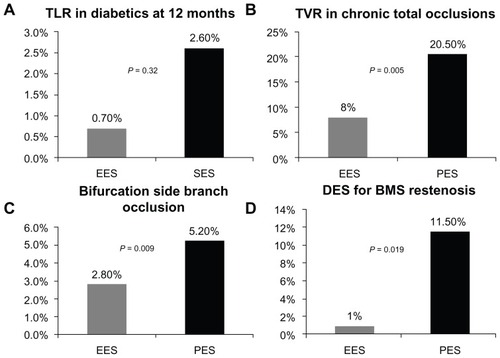Figures & data
Table 1 Development of bare metal and drug-eluting stents led to a reduction in rates of abrupt closure, emergent CABG, restenosis and target lesion revascularization when compared with PTCACitation2,Citation13,Citation14
Table 2 Comparison of the platform composition, strut thickness, and polymer of major drug-eluting stents
Table 3 Summary of the Clinic Evaluation of the XIENCE V Everolimus Eluting Coronary Stent System in the Treatment of Subjects with de Novo Coronary Artery Lesions (SPIRIT) trials comparing EES and PES, showing superior 12-month target lesion revascularization (target lesion revascularization) and overall restenosis results, with similar to improved rates of stent thrombosis and VLSTCitation52,Citation54,Citation55
Figure 2 Everolimus use in special populations. Reduced target lesion revascularization was seen in patients with diabetes treated with the EES compared with sirolimus-eluting stents (A). When compared with paclitaxel-eluting stents, the use of EES was associated with lower rates of target vessel revascularization in chronic occlusions (B), less side branch occlusion in bifurcation stenting (C), and improved restenosis rates in the treatment of BMS ISR (D).

Table 4 Overview of everolimus-eluting stents available in United States
